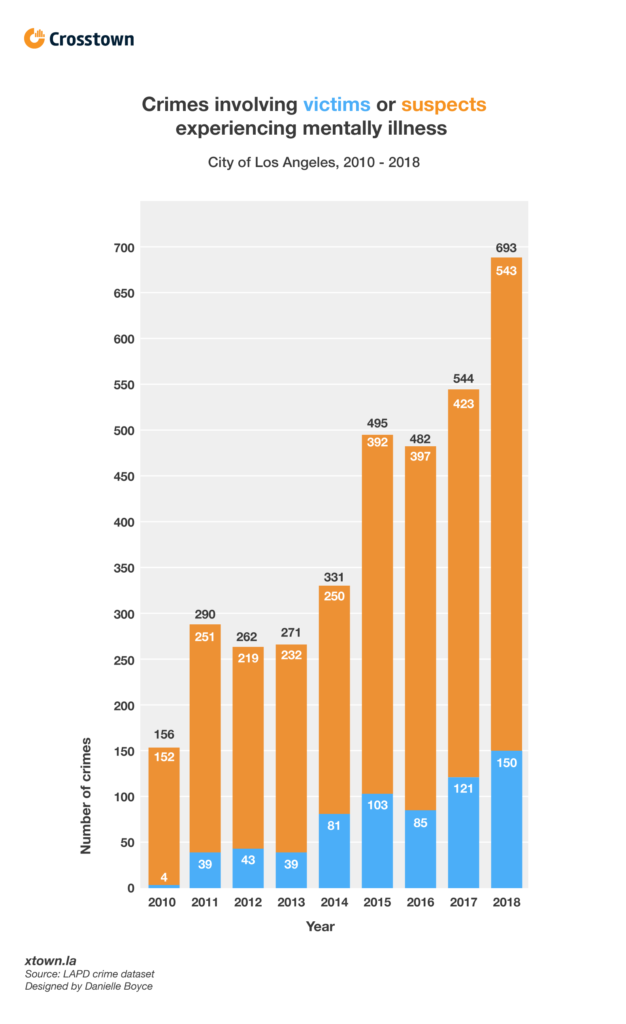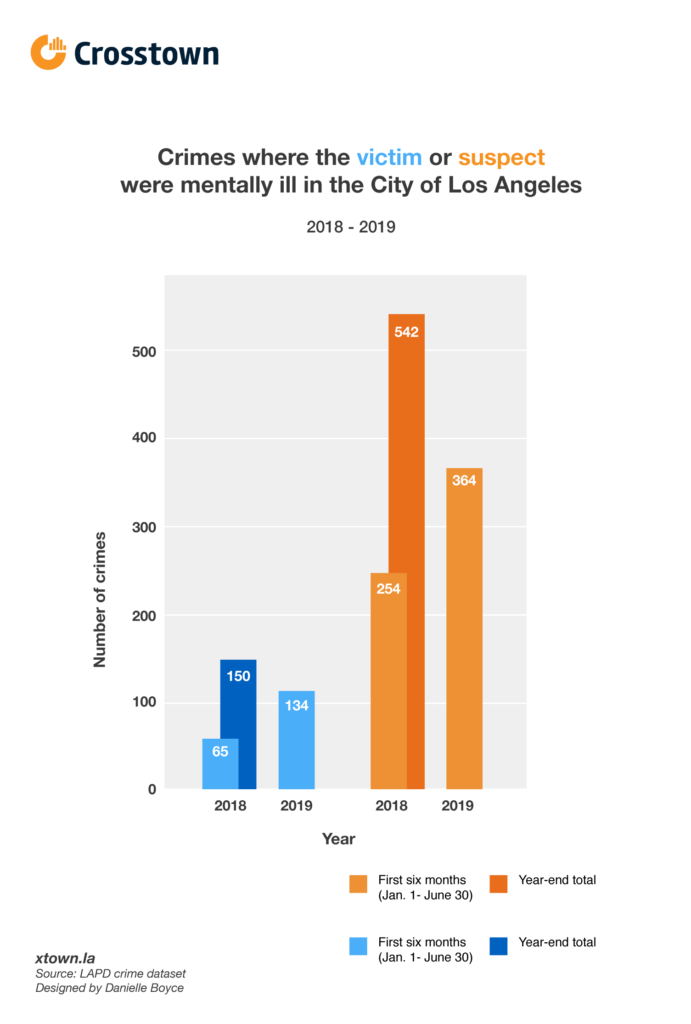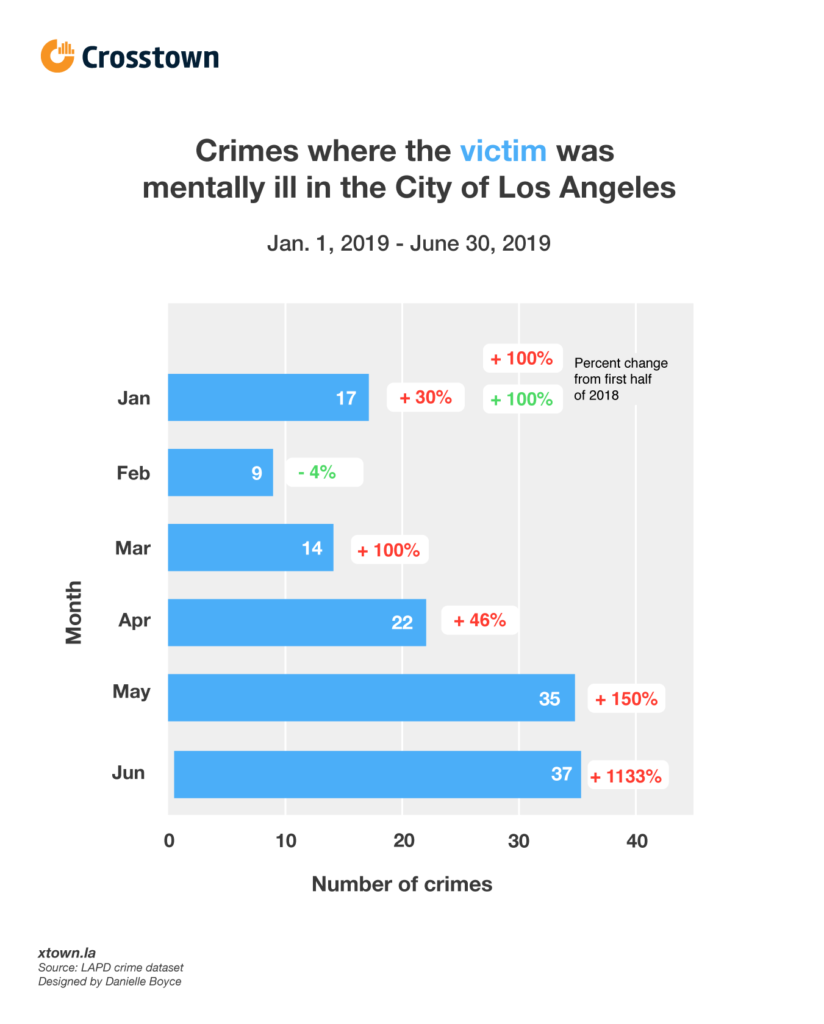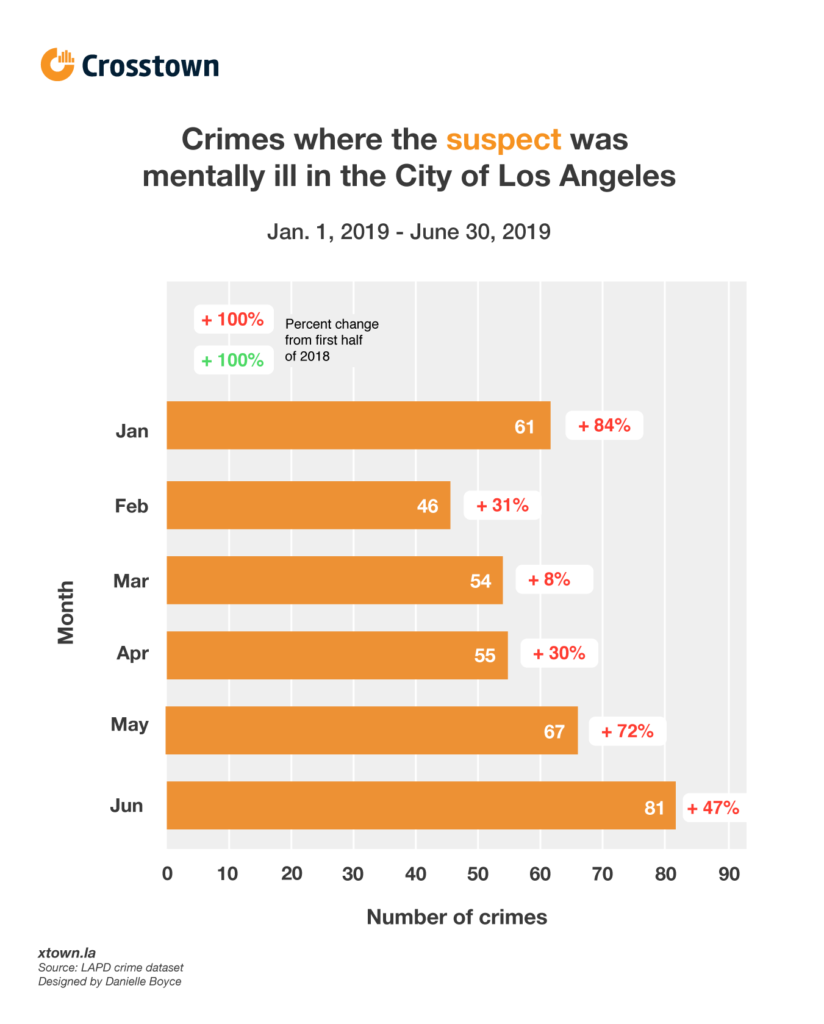The growing presence of mental illness in crime data

In Los Angeles, jails and mental illness are often used in the same sentence.
That was especially true this week when the LA County Board of Supervisors voted Tuesday to scrap a $1.7 billion contract for a downtown mental health treatment center to replace Men’s Central Jail in Downtown Los Angeles.
Advocates said the planned facility was just a jail masquerading as a hospital.
According to publicly available LAPD crime data, there is a trend of rising crime involving the mentally ill in the City of Los Angeles. Crimes involving the mentally ill have increased 338% from 2010 to 2018 (the most recent year for which we have complete data).

And in just the first six months of 2019, the number of mentally ill people who were either the victim or suspect of a crime in the City of Los Angeles spiked, with 498 reported crimes, a 56% increase from the same time period (Jan. 1 – June 30) in 2018.
The month of June 2019 had the highest number of reported crimes with either a mentally ill victim or suspect since the LAPD started making its data publicly available in 2010, with an average of 3.9 crimes per day. The daily average for the total period of Jan. 1 – June 30, 2019 was 2.7 crimes per day.

One out of every three inmates in the average Los Angeles County jail suffers from a diagnosable mental health disorder, prompting some to call it the nation’s largest mental health facility.
“We find that jails, first of all, need to determine who in their jail has a serious mental illness, as well as co-occurring substance use disorders,” said Risë Haneberg, a behavioral health advocate at the Council of State Governments Justice Center. “Once the population is identified, it is essential that jails begin to document and track the necessary data to better understand the prevalence rate and the capacity needs for serving this population.”
The number one crime against mentally ill victims in the first six months of 2019 was aggravated assault with a deadly weapon, with 45 total incidents. There were 19 incidents of battery-simple assault and 17 rapes.
In addition to the 17 reported rapes, there were many other reports of intimate partner and/or sex-related crimes, including:
– Six reports of “intimate partner simple assault.”
– Four reports of “sexual penetration with a foreign object.”
– Three reports of “sodomy.”
– Two reports of “oral copulation.”
– One report of “battery with sexual contact.”
– One report of “intimate partner aggravated assault.”
– One report of “unlawful sex.”
One case of aggravated assault with a deadly weapon occurred at 4 a.m. on the sidewalk at Grand Ave. and Venice Blvd., in Downtown. The suspect approached the 36-year-old mentally ill Hispanic female victim from behind, knocked her to the ground, choked her and took pictures of her.
Last year, there were 693 total crimes where either the suspect or victim was mentally ill, a 27% increase from 2017. Of the crimes committed in 2018, 60% were violent, with the most common crimes committed being battery-simple assault and aggravated assault with a deadly weapon.
Law enforcement is one of several institutions at the front lines of interacting with people experiencing mental illness, and that relationship can be fraught.
According to the LAPD, officers go through extensive mental health training that includes a 40-hour course covering issues such as self-care for officers in stressful situations and how to de-escalate potentially violent situations.
“We try our best to teach our officers how to react to these situations and to recognize that these people might be reacting to internal mental stimuli,” said Lt. Brian Bixler, who heads the LAPD’s Crisis Response Unit, which is a team of volunteers that act as a liaison between emergency personnel and the victim. “The priority is always de-escalation.”
“About 60% of the calls we get, a clinician can actually accompany an officer to the scene of the crime, and it really helps when there’s a mental health professional on call.”
According to Bixler, the LAPD’s strategy for officers encountering people with mental illness is about getting people what they need.
“That could be a stay at the hospital or we could release them at the scene of the crime,” he said. “Unfortunately, sometimes, jail time has to be involved. People can’t avoid the law because of mental illness.”


How we did it: We examined publicly available LAPD data on reported crimes involving people with mental illness. For neighborhood boundaries, we rely on the borders defined by the Los Angeles Times. Learn more about our data here.
LAPD data only reflects crimes that are reported to the department, not how many crimes actually occurred. In making our calculations, we rely on the data the LAPD makes publicly available. The LAPD does periodically update past crime reports with new information, which sometimes leads them to recategorize past reports. Those revised reports do not always automatically become part of the public database. We try to update our reporting when new data becomes available.
Want to know how your neighborhood fares? Or simply just interested in our data? Email us at askus@xtown.la.






